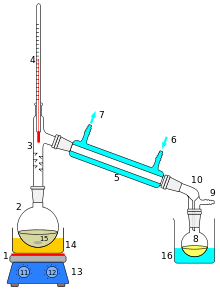സ്വേദനം

സ്വേദനം എന്നാൽ ഒരു ദ്രാവകമിശ്രിതത്തിന്റെ ഘടകങ്ങളെ ബാഷ്പീകരണവും നിയന്ത്രിത സാന്ദ്രീകരണവും വഴി വേർതിരിക്കുന്നതിനുള്ള പ്രക്രിയയാണ്. ഇത്, ഒന്നുകിൽ പൂർണ്ണമായ വേർതിരിക്കലോ (എതാണ്ട് ശുദ്ധമായ ഘടകങ്ങൾ ആയിരിക്കും) അല്ലെങ്കിൽ ആ മിശ്രിതത്തിലെ ഘടകങ്ങളുടെ ഗാഢത കൂട്ടാനായി ഭാഗിക വേർതിരിക്കലോ ആകാം. ഇതിലേതു കാര്യത്തിലായാലും, മിശ്രിതത്തിന്റെ ഘടകങ്ങളുടെ ബാഷ്പമാകുന്നതിന്റെ കഴിവ് ആണിവിടെ ചൂഷണംചെയ്യുന്നത്. വ്യാവസായിക രസതന്ത്രത്തിൽ, സ്വേദനം പ്രായോഗികമായി സാർവത്രികമായ പ്രാധാന്യമുള്ള ഒരു ഘടകപ്രവർത്തനമാകുന്നു.. പക്ഷെ, അത് ഒരു രാസപ്രവർത്തനമല്ല മറിച്ച്, ഒരു ഭൗതിക വേർതിരിക്കൽ പ്രക്രിയയാകുന്നു.
വാണിജ്യപരമായി, സ്വേദനപ്രക്രിയയ്ക്ക് വളരെയധികം പ്രയോജനങ്ങളുണ്ട്. ഉദാഹരണങ്ങൾ ചിലത് താഴെക്കൊടുക്കുന്നു:
- ഫോസിൽ ഇന്ധനങ്ങളുടെയും അസംസ്കൃതവസ്തുക്കളുടെയും വ്യവസായത്തിൽ, ക്രൂഡ് ഓയിലിൽ നിന്നും വിവിധ ഇന്ധനങ്ങൾ വേർതിരിക്കുന്നതിലും മറ്റു വ്യവസായങ്ങൾക്കു വേണ്ട അസംസ്കൃതവസ്തുക്കൾ വേർതിരിക്കുന്നതിലും സ്വേദനം ഒരു പ്രധാന ശുദ്ധീകരണപ്രക്രിയയാണ്.
- വ്യാവസായിക ആവശ്യത്തിനായി, വായുവിൽ നിന്നും ഓക്സിജൻ, നൈട്രജൻ, ആർഗൺ തുടങ്ങിയവ വേർതിരിക്കുന്നതിനു സ്വേദനം സഹായിക്കുന്നു.
- വ്യാവസായിക രസതന്ത്രത്തിൽ, ദ്രാവകരൂപത്തിലുള്ള രാസോല്പാദനപ്രക്രിയയിൽ ഉണ്ടായ വസ്തുക്കളായ അസംസ്കൃതപദാർഥങ്ങളിൽ നിന്നും ശുദ്ധമായ പദാർഥങ്ങൾ വേർതിരിക്കുന്നതിനു ഈ പ്രക്രിയ ഉപയോഗിക്കുന്നു.
- പുളിപ്പിച്ച വസ്തുക്കളിൽനിന്നും സ്വേദനം വഴി ഉയർന്ന ആൽക്കഹോൾ അടങ്ങിയ പാനീയങ്ങൾ നിർമ്മിക്കുന്നു.
ആൽക്കഹോൾ പോലുള്ള പാനീയങ്ങൾ നിർമ്മിക്കാനായി തയ്യാറാക്കിയ യന്ത്രങ്ങളുടേയും മറ്റും സംവിധാമാണ് ഡിസ്റ്റില്ലറി. സ്വേദനം ചെയ്യാനുള്ള ഉപകരണങ്ങളെ (Still)സ്വേദനസംവിധാനം എന്നു പറയുന്നു.
ചരിത്രം
[തിരുത്തുക]സ്വേദനത്തിന്റെ പ്രയോഗക്ഷമത
[തിരുത്തുക]സ്വേദനമാതൃക
[തിരുത്തുക]പരീക്ഷണശാലയിലെ സ്വേദനരീതികൾ
[തിരുത്തുക]വ്യാവസായിക സ്വേദനം
[തിരുത്തുക]ഭക്ഷണസംസ്കരണത്തിൽ സ്വേദനം
[തിരുത്തുക]ഇതും കാണൂ
[തിരുത്തുക]അവലംബം
[തിരുത്തുക]കൂടുതൽ വായനയ്ക്ക്
[തിരുത്തുക]- ↑ Harwood, Laurence M.; Moody, Christopher J. (1989). Experimental organic chemistry: Principles and Practice (Illustrated ed.). Oxford: Blackwell Scientific Publications. pp. 141–143. ISBN 978-0-632-02017-1.
((cite book)): Invalid|ref=harv(help)
Text is available under the CC BY-SA 4.0 license; additional terms may apply.
Images, videos and audio are available under their respective licenses.
